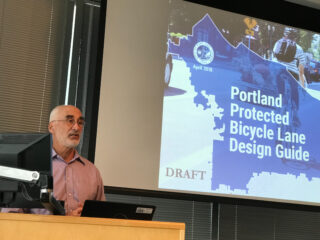
(Photos: Jonathan Maus)
Portland has been talking about physically protected bike lanes for years. The problem is, we’ve mostly just been talking — and not building. And when we have built them, the designs have been inconsistent.
One of the (many) reasons for the slow implementation of protected bike lanes is that engineers, planners, and project managers at the Portland Bureau of Transportation haven’t been reading from the same book. In fact, they haven’t even had a book. Until now.
Last week PBOT’s bicycle program manager Roger Geller shared a sneak peek at a new manual that will soon be adopted as the official Portland Protected Bicycle Lane Design Guide.
“We’re going to start with a protected bike lane and you better have a really good reason why can’t do it.”
— Roger Geller, PBOT
“It provides much-needed clarity about what we can build and how it will fit on Portland streets,” Geller told an audience of several dozen (mostly planning students) at a “Lunch and Learn” event hosted by PBOT at Portland State University last Thursday. Geller said the guide came about in large part because outgoing PBOT Director Leah Treat issued an internal agency directive in 2015 that called on staff to make protected bike lanes the default whenever possible. “That directive kind of flipped things on its head for our agency,” Geller explained. In the past they would start from a standard, six-foot bike lane and work up toward protection. Now, Geller said, the approach is different: “We’re going to start with a protected bike lane and you better have a really good reason why can’t do it.”
Treat’s memo was just one part of the impetus for this guide. Geller also shared that it was born from a struggle by PBOT engineers to come up with designs. “Our first five protected bikeways were all different designs,” he explained. “We’d sit down and say, ‘What should we do?’ And Engineer A says, ‘I know, let’s do this.’ Then another street would come up, and we’d say, ‘What should we do for this one?’ And it would be a completely different design.” “The first five were all one-offs,” he continued. “At a certain point our engineers were begging for mercy, saying, ‘Give us some tools!’ The existing guidebooks weren’t sufficient.”
(Click images for gallery and captions. ESC to return to post.)
The bulk of the guide lays out different street cross-sections and suggests seven basic designs. This is meant to help city staff determine what’s possible given nearly any street configuration they come across — from a 76-foot wide, two way road to a 44-foot one-way road. The final guide will include an online spreadsheet tool that will allow engineers and project managers to plug in a specific cross-section and receive design ideas that will fit.
Let’s say PBOT plans to redesign a 36-foot wide roadway like NW Thurman, which today has two vehicle lanes and two lanes used for parking cars. Project staff could turn to this new design guide and see how to layout the street with six-and-a-half foot bike lanes protected from motor vehicle traffic with a one-and-a-half foot buffer zone that could be filled with a cement curb or plastic delineator wands.
Those wands are all too familiar to many Portlanders. They are often damaged, driven over, and knocked down by drivers. So much so they’ve tarnished the name of protected bike lanes. Geller fells our pain. He acknowledged on Thursday that the wands aren’t working as well as he’d hoped. “If you would ask me a year ago what Portland was going to look like with protected bikeways, I would have said we were going to become a city of delineator-post protected bikeways,” he said. “But based on the experience we’ve had with them, I think we’re going to have a more nuanced approach.” Citing exorbitant maintenance costs, Geller said PBOT is still learning what type of locations they work well in, and where other options might work better.
Another maintenance issue is whether or not sweepers can access protected bike lanes. The guide includes “sweeping access width” measurements for all the designs so maintenance staff will know which sweeper is needed for the job.
Advertisement
Where designs beyond plastic posts make sense, this new guide will help PBOT determine what to use. It includes guidance on other materials that can be used for protection: traffic separators (curbs), concrete islands, planters, or parked cars.
(Click images for gallery. ESC to return to post.)
Of course these other options are more expensive than delineator posts, and therein lies the rub. Geller said traffic separator curbs are four times the costs of the posts, “Which can be a stretch for us.”

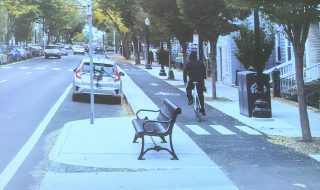
(Photo: PBOT/Roger Geller)
For projects with a larger budget, the guide also lays out PBOT’s preferred design: a bikeway separated from other traffic and elevated to the same level as the sidewalk. Geller said that design — which requires 21-feet of width to fit an eight-foot sidewalk, seven-foot bike lane and six-feet of buffer space — is preferred because of its flexibility and the sense of protection it provides.
While there aren’t many opportunities for PBOT to build their dream design (the guide focuses primarily on retrofits, not new construction), Geller said they’ve also done a mapping process to identify roads with potential for protected bike lane treatments. He said, “We’ve got about 450 miles of roadways we’re identifying for these kind of treatments.”
As for how much these retrofits would cost, it depends on the design. On the low-end, PBOT estimates a basic, parking protected bike lane on a one-way road would cost $70,000 per mile. On the high-end, if they were to convert a road with five standard vehicle lanes to three and add protected bike lanes separated by a concrete island it would cost them $2.8 million per mile.

One thing you won’t find in the guide is the issue of how to address intersections. Geller said that’s because those solutions are constantly evolving. As PBOT continues to do their own research and analysis, they rely on existing manuals from other agencies and organizations that have already established best practices.
When it came time to answer questions from the audience, several people (including myself) wanted to know if having this guide in hand would lead to faster implementation. “I think this will facilitate faster implementation,” Geller said. With PBOT engineers now working from a standard set of drawings, it will be easier for them to decide what to do. But the limiting factor isn’t engineering, it’s money. “The thing that will hasten them is funding,” Geller added (and then pointed out how PBOT already has money for miles of protected bike lanes on deck for the Central City in Motion project and projects coming on North Rosa Parks, Denver, Greeley and elsewhere).
Also worth noting is that many streets that already have painted buffers will now be even stronger candidates for some sort of physical protection.
Overall, having this guide should significantly improve Portland’s ability to install protected bike lanes. While it gives PBOT a helpful tool, Geller said he hopes we, “Don’t let the perfect be the enemy of the good.”
“We recognize we’re going to fail at times,” he said. “We’re not always going to be able to get our ideal design; but at least we know what we’re striving to achieve.”
The new guide is expected to be adopted by City Council by the end of June. I’ll post a public version once it’s released.
— Jonathan Maus: (503) 706-8804, @jonathan_maus on Twitter and jonathan@bikeportland.org
Never miss a story. Sign-up for the daily BP Headlines email.
BikePortland needs your support.






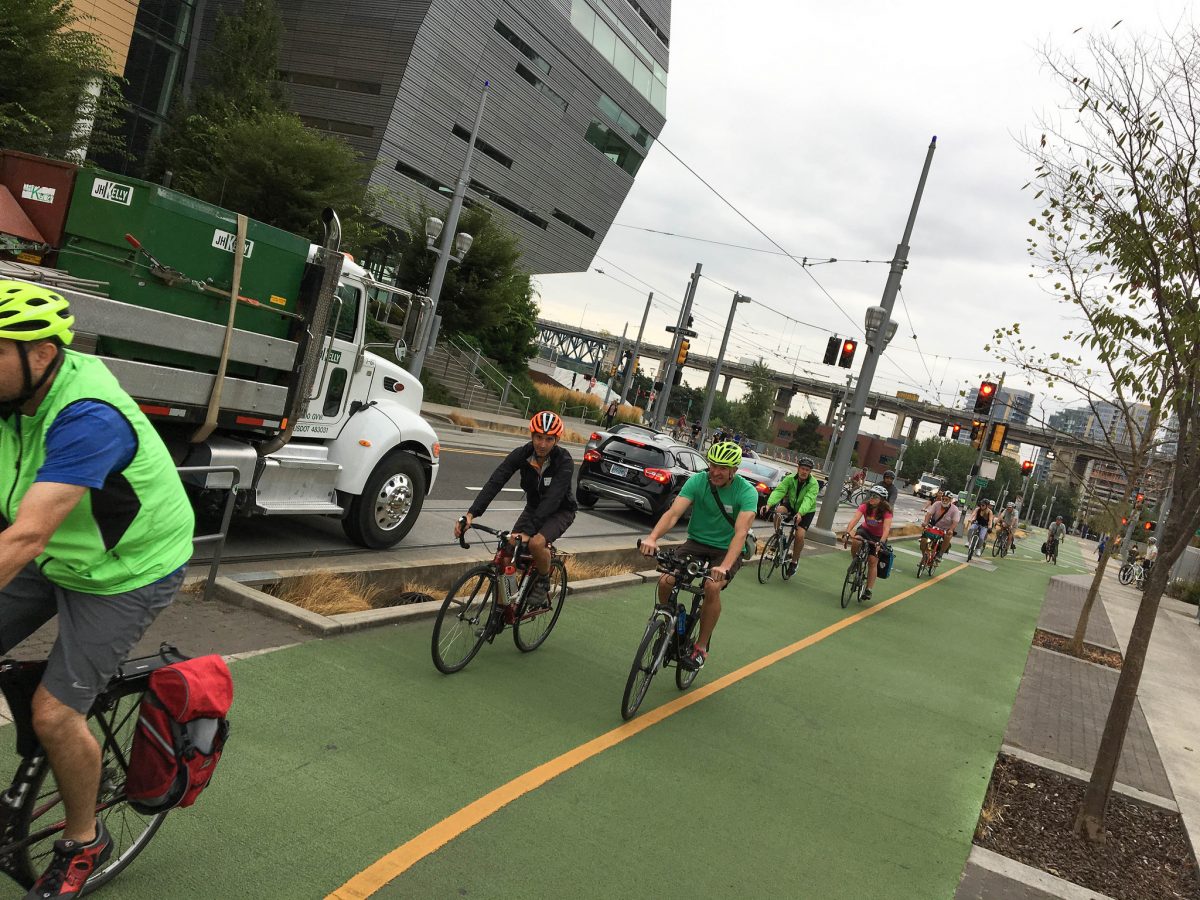









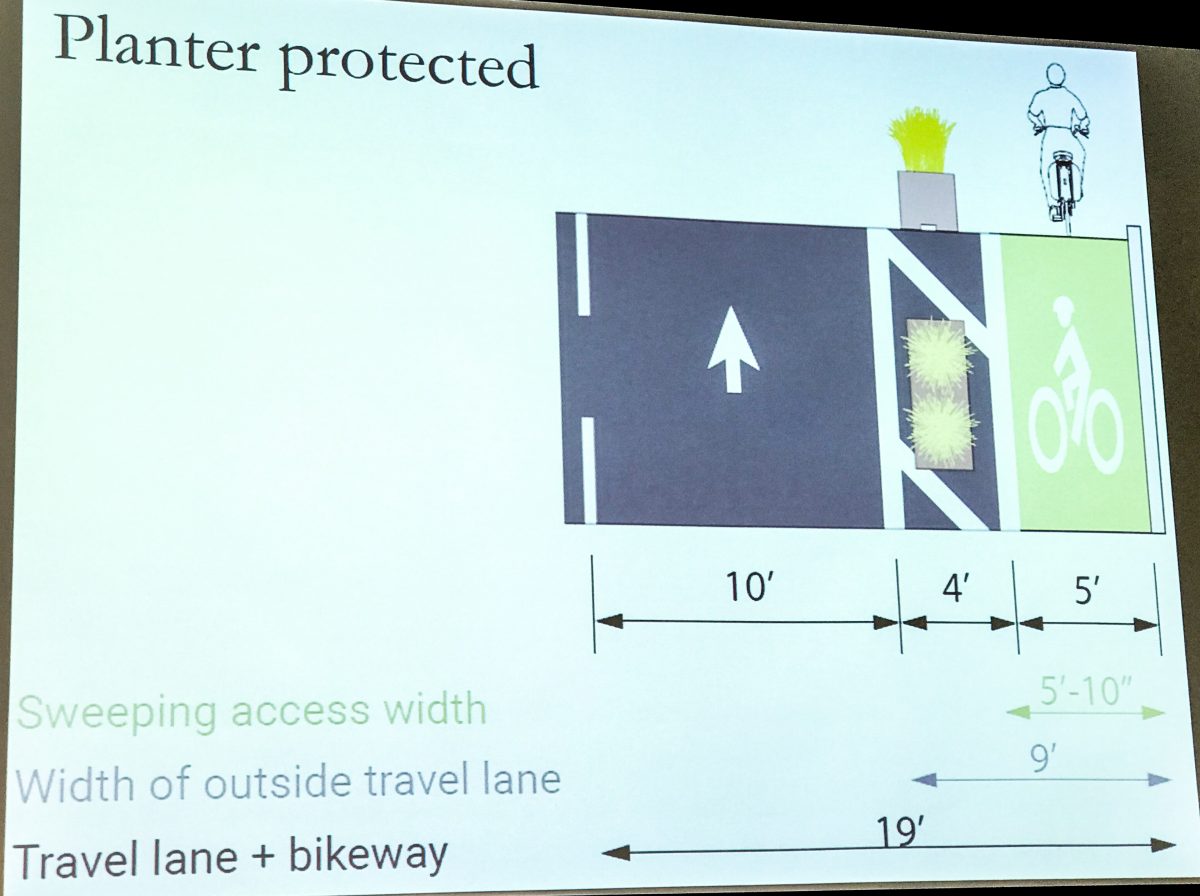
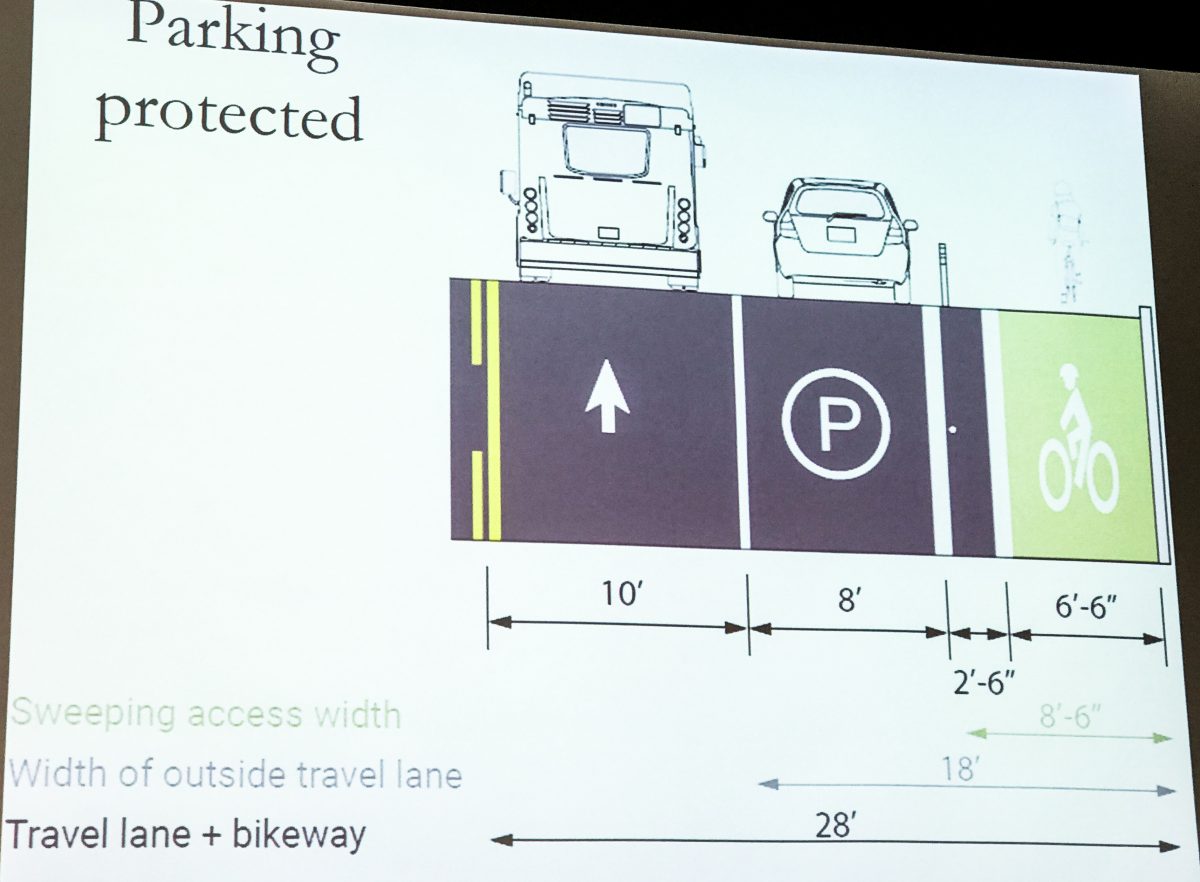
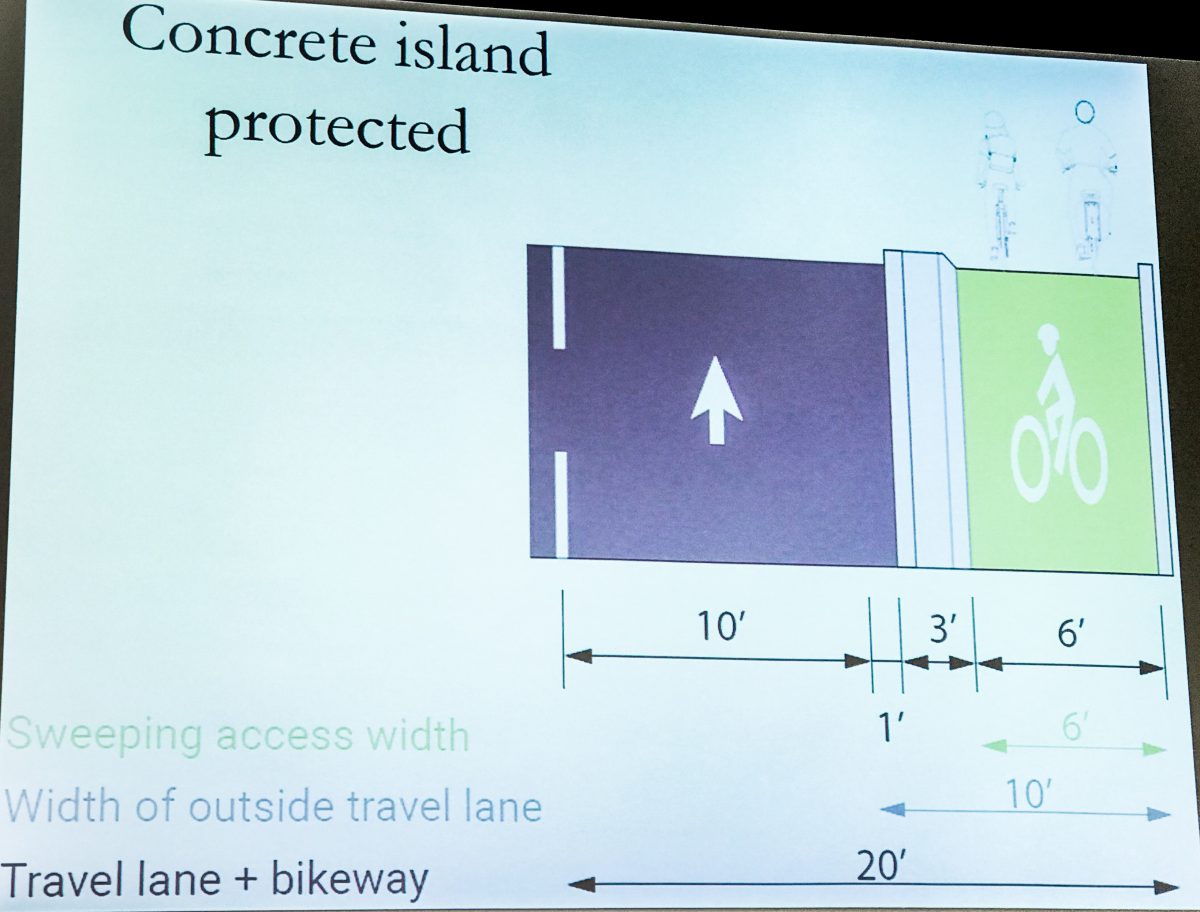
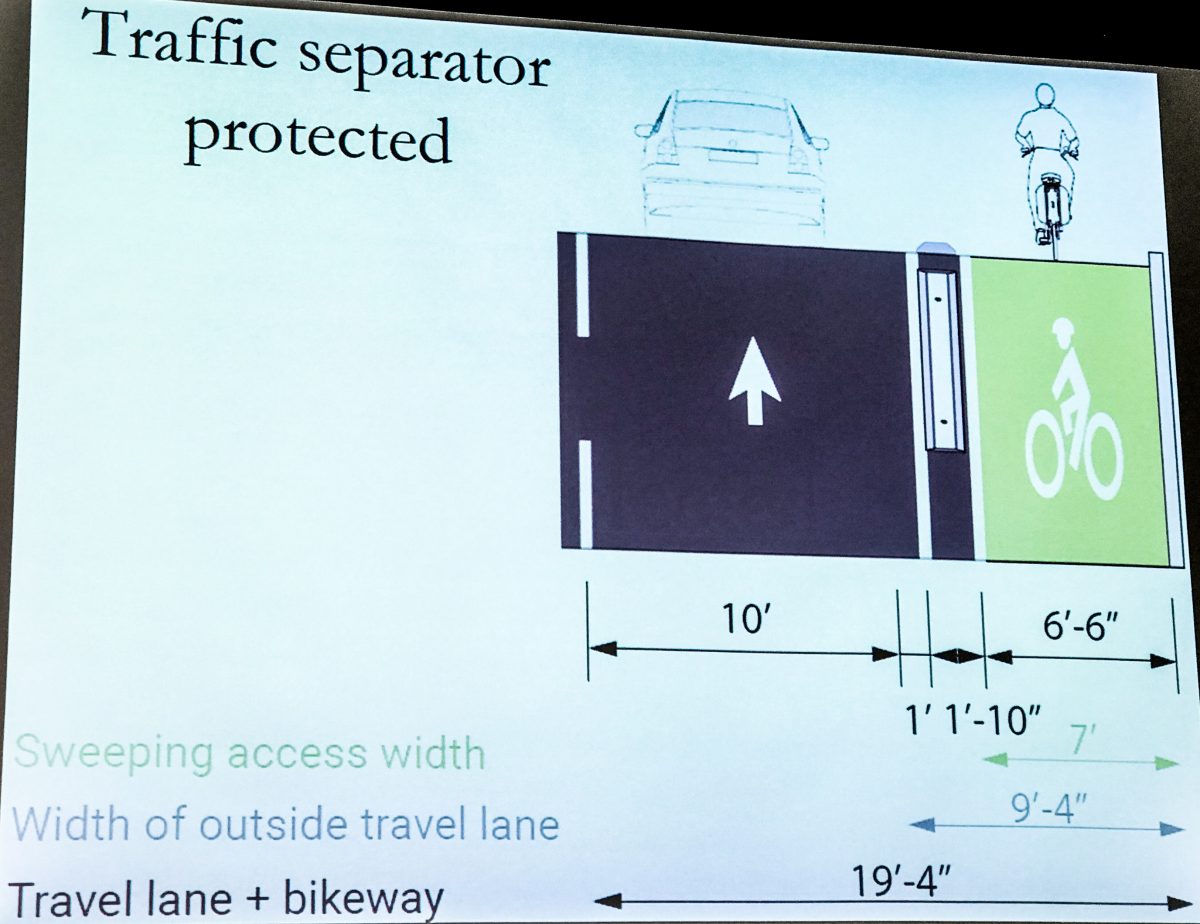

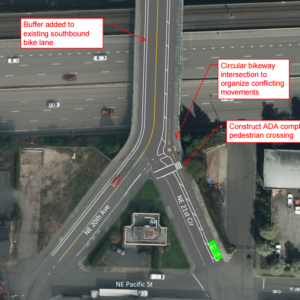

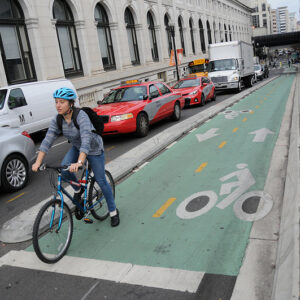

Thanks for reading.
BikePortland has served this community with independent community journalism since 2005. We rely on subscriptions from readers like you to survive. Your financial support is vital in keeping this valuable resource alive and well.
Please subscribe today to strengthen and expand our work.
“One thing you won’t find in the guide is the issue of how to address intersections. Geller said that’s because those solutions are constantly evolving.”
And that’s why so-called “protected” bike lanes have so few places where they are truly the best option. In an urban setting, intersections are the issue and so-called “protected” bike lanes make intersections more dangerous.
Let’s not make the perfect the enemy of the good, but let’s not do things that are bad in the name of not being perfect either.
protected bike lanes that maintain clear site lines near an intersection are no worse than a conventional bike lane.
It’s also important to have clear sightlines at driveways, which, in some environments, are far more frequent than intersections.
No better either….
The protected lanes in Portland, Multnomah, Broadway, etc. are the worst lanes in town.
Never swept, impossible to pass, and you do end up at an intersection completely surprising any cars or pedestrians.
An expensive worthless gimmick.
so let them ride next to 5 ton vehicles hurtling along at 40 mph?
the assumption that everyone — children, adults, older folk — is willing to develop this kind of “learned helplessness” is absurd. study after study has shown that perceived risk is a huge barrier to more widespread adoption of cycling for transportation:
https://www.citylab.com/transportation/2016/01/the-4-types-of-cyclists-youll-meet-on-us-city-streets/422787/
If the only alternative to perceived risk is real risk, we have a problem. We need ways to create bike lanes that provide protection without the drawbacks of parking-protected bike lanes.
there is safety in numbers. this is why perceived risk is important.
Of course, but it shouldn’t come at the cost of actual safety.
The Portland cycling community is still having the discussion about whether to implement best practices from the Netherlands, which have been proven to support safe and abundant cycling for everyone.
Is you want to blame anyone for the stagnation of cycling there, blame the people perpetuating this discussion. This debate is over in the cities where cycling is booming.
Or driveways.
One reason protected bike lane designs work so well in places like Amsterdam is that many streets run along canals, the blocks are much longer, and there are few intersections and few if any driveways.
In Portland, it’s easy to add a protected bike lane along a block face, but it’s the intersections and driveways that present the most difficult challenges. If Portland is still ‘experimenting’ with intersection designs, this design guide is being released prematurely and the program is still not ready for prime time.
Will Multnomah County use this for their future road projects ?
I wonder if other countries have design standards/solutions that we could use versus trying to spend years reinventing the wheel….hmmmmm.
Yep. This graphic from Copenhagenize just about sums it up: Four types of bicycle lanes depending on the speed of the traffic:
http://www.copenhagenize.com/2013/04/the-copenhagenize-bicycle-planning-guide.html
The Dutch have the CROW manual, which apparently was recently translated to English as well. But it’s not free: https://peopleforbikes.org/blog/the-worlds-best-bikeway-manual-just-updated-and-its-in-english/.
Portland is also a NACTO member. https://nacto.org/publication/urban-bikeway-design-guide/
These guidelines are going to be a disaster for some fast, experienced, skilled, year-round cyclists who have been cycling for 30+ years (and this is a good thing).
remind me why this would be a good thing?
because more people cycling for transportation is a good thing
why cant we have infrastructure that caters to both fast and slow cyclists (ie passing lanes)?
car culture.
until non-single-occupancy-vehicle mode share decreases substantially carving off every 6-10 feet of roadway for active transportation is a huge fight.
The vehicular cycling approach of the past few decades in the US has resulted in cycling modal share rates well under 1%, and world-leading fatality rates. It’s time to try something new.
Vehicular cycling is a good way to safely navigate inadequate infrastructure. It is not at odds with building better facilities, where vehicular cycling may not be necessary.
“Vehicular cycling is a good way to safely navigate ”
evidence please.
What’s the alternative when there’s no infrastructure? Riding on the sidewalk?
the alternative is mostly not riding.
instead of whining about being ever so slightly inconvenienced by new infrastructure (get off my lawn!) existing bike commuters should be celebrating efforts to duplicate vancouver bc’s incredible success:
https://bikeportland.org/2016/05/06/vancouver-biking-doubles-passing-portland-with-downtown-protected-bike-lane-network-182716
Then you would agree with this (slightly modified) statement?
Vehicular cycling is the only way to safely navigate inadequate infrastructure by bike.
“Vehicular cycling is the only way to safely”
i would not agree to this at all. i have no opinion on the relative safety of VC cycling because there is, to the best of my knowledge, no evidence that it is genuinely safer than other styles of cycling.
“Riding on the sidewalk?”
in fact, one of the primary studies that VC proponents cite to bolster their claim that sidewalk riding is unsafe shows nothing of the sort.
in this study “same direction as traffic” sidewalk riding was shown to be about as safe as same-direction riding in the roadway:
http://www.bicyclinglife.com/Library/Accident-Study.pdf
Riding on the sidewalk is like driving in the bike lane.
People drive in the bike lane because they are afraid of using the main lane?
Yes, that’s it exactly.
No. Motorist drive in the bike lane because it’s inconvenient for them to slow their motor vehicles (e.g. wait for a left-turning vehicle). Bicyclists ride on the sidewalks mostly to avoid what they perceive to be unsafe conditions on the street, but also sometimes because it is inconvenient for them (e.g. to avoid going around the block to avoid one-way streets).
One bit of evidence is every right hook incident ever. Right hook collisions are virtually eliminated if bicyclists do not attempt to stick to the right side of the road out of the view, but in the frequent turning path of motorists. In the absence of good protected bikeways, using bike lanes as they were intended—or following the “out-of-the-way-of-cars” principle ingrained by them—results in more potential and actual crashes between bike riders and drivers.
Anecdotally, the only time I’ve been hit by a car is when following every law while using MUP/Crosswalk “infrastructure”. Failing to read the minds of drivers can be dangerous.
Ah, but most of the people who participate in VC actively oppose protected infrastructure. See: this post and the comments section.
That may be true, but that is a reflection of those riders rather than the underlying concept.
And anyway, what is the alternative when infrastructure is lacking? Cowering in the gutter?
They oppose that being the ONLY infrastructure.
We need to build different types of infrastructure for different speeds of riders.
Yes
“Our first five protected bikeways were all different designs,”
*sigh*
we don’t have any protected bikeways… we have separated bikeways with very little protection…
looking forward to getting our first real one…
I should clarify that we have no protected BIKE LANES… as in the mandatory sidepath kind… there is a protected bikeway by the new Tillikum bridge… but I consider that a TriMet thing more than a City of Portland thing…
What do you consider protected? I believe that the protected bikeway projects that RG was referring to as all having different designs included SW Broadway near PSU, NE Multnomah Street near the Lloyd Center (where it’s protected w/ planters), SW Moody Ave in the south waterfront, maybe NE Cully Boulevard is in that list too.
Disagree with Roger Geller on funding. Funding is a convenient excuse for public agencies. The reality is funding is never enough, but a project on the wish list is different from a project that has funding but is hung up by other factors. Most of the time, a project is delayed because of backlash from residents and businesses and PBOT’s lack of strong will to see a project through on time. Having a guide will certain make engineers feel more comfortable, but I don’t think most bike projects are delayed by PBOT’s engineers.
Here’s a really good article from the Seattle Times, I’d recommend you read it because it’s a surprisingly nuanced look at costs associated with good bikeway designs. It’s a shame that we don’t have this level of thoughtful analysis in our local news outlets.
https://www.seattletimes.com/seattle-news/transportation/12-million-a-mile-heres-how-bike-lane-costs-shot-sky-high-in-seattle/
I am very hopeful they’ll not proceed with any design that places bicycle riders between parked cars and the sidewalk. The drivers and passengers of those parked cars will unload their crap into the bike lane. The drivers and passengers of those parked cars will cross the bike lane without looking. The drivers and passengers of those parked cars would be better served with parking next to their destination: the sidewalk.
So, should we remove sidewalks? You know, cars just dumping there stuff onto them..
They’re doing it right now on Rosa Parks. It’s terrible. But there are much better arguments against it than where drivers put their stuff. Visibility is the major danger. Being obscured by parked cars makes me VERY uncomfortable.
What’s the best-practice for speed limits next to a parking-protected bike lane? I’m going to guess 20mph. If engineers design for 20mph traffic in the bike lane and car lane, it should work fine. This means giving up parking spaces for safety though, and Portland refuses to acknowledge that elephant.
I know. They refuse to even acknowledge ORS 811.550(17).
Design skills not PBOT’s strong suit.
Actually, their civil engineers have many fine designers. But you’ve really nailed it – this a design guideline by planners, for planners, not the engineers who make all the administrative decisions at PBOT and other DOTs.
The price difference is really quite staggering. The lowest cost option costs only 2.5 % of the highest cost option (70k versus 2.8 Mio). Transforming the 450 miles mentioned would then cost 31 Mio for the lowest cost option versus 1.26 billion for the deluxe version. Then again, the city plans to drop a billion or so on a few miles of highway “upgrade”, enough money to essentially get all of these 450 miles trabsformed to excellent bike safety standards. Priorities!
The State plans to spend money on highways, not the city.
I think there are situations where parking-protected lanes can work, but not in most settings.
In Minneapolis, well ahead of Portland in putting in protected bike lanes, we have a couple places where there is a parking-protected bike lane that goes for one block (26th St at Nicollet, not in Google Street View yet), but we’ve actually removed the one major parking-protected bike lane (N First Ave) that we had, and replaced it with a regular buffered bike lane.
In true Portland half measure style, zero guidance on intersections. You know, where people die. On bikes.
Thanks for the update, David.
I am puzzled why the Water Bureau, an engineering organization, is led by an engineer, but at PBOT, also an engineering organization, no such qualification is required.
Neither LT nor RG are, in my opinion, remotely qualified to be where they are.
The finest designer in the history of Oregon was Conde McCullough. More than a structural engineer, he was a brilliant mathematician and theorist, who set the enduring standards of design for arch and suspension bridges.
If we are to do effective infrastructure for bicycles we should get someone of proven experience and stature, probably from Europe, to lead. Anyone have any ideas?
Designing bike lanes doesn’t require “engineering” in the strict sense. There is no real calculation involved.
Engineers rarely “calculate” anything. They are trained in problem solving, analysis, and design. Street design is an engineering problem, and we should have engineers making the decisions.
Civil engineering is a literally a whole profession.
It’s actually a whole bunch of fairly disparate professions, all of which involve calculation.
The reason water and sewer providers are led by engineers and transportation bureaus are not is because 1) the pipes are underground and people can’t see them; 2) people have no idea how pipes work (do hydraulic jump or laminar flow ring a bell?) and they realize that they need engineers to do that stuff; 3) everyone with a driver’s license thinks he/she is a traffic engineer.
ODOT is dominated by traffic engineers, do we like their approach to roads?
ODOT is hardly dominated by traffic engineers. There are lots more non-engineers than there are engineers and traffic engineers account for only a small subset of the engineers. Neither the ODOT Director nor the Region 1 Manager is an engineer. Maybe that’s the problem. Maybe not.
The parking protected bike lanes are claustrophobic, reduce visibility, and increase the likelihood of getting hooked, especially at night. They’re really awful. Which means that PBOT will continue implementing them.
I agree as far as parking protected is concerned. There are plenty of ways to protect a bike lane without reducing visibility. And if you look at safe cities, protected bike lanes are a big part of their infrastructure. Vehicular cycling works for a very specific segment of the biking population and is not the way forward.
Someone else said it first “let’s not make perfect the enemy of good.” Portland has many places where it has “experimented” with changing bike lanes. Williams Ave. South Waterfront. Now Rosa Parks. Have you SEEN the lines painted on the newly repaved roadway there? One block you’re at the curb in a normal bike lane, the next there are cars parked to your left, and the next block is even something weirder. Has ODOT even studied how motorists disregard fancy, bold white and green lines on the road? Now cyclists will be forced to weave left and right to go straight along a road THAT WORKED JUST FINE TWO WEEKS AGO. Awesome that Portland civic planners want to find a “solution” but you can’t slap different solutions around willy nilly and expect it to have any overall impact. I , for one, am tired of being the guinea pigs for ODOT’s experimentation. I guess I’ll have to find an alternative to Rosa Parks now when headed home because I prefer just riding on the road, not a Disney-esque obstacle course.
It’s not ODOT; it’s Portland Bureau of Transportation (PBOT).
What about on extremely busy roads with lots of freight traffic and cars and buses?
There’s a lot of research that protected bike lanes help cyclists feel safer and encourage more commutes/errands/trips by bike. But by all means, ride in the traffic lane if you feel more comfortable that way.
It helps cyclists who don’t know any better to feel safer. Folks who have been regularly cycling in urban environments know that limited sight lines at intersections are crashes waiting to happen. I feel sorry for new cyclists who aren’t aware of these dangers, and who unwittingly endanger themselves even while they feel that they are safer.
I am suspicious of Geller. He seems over-willing to compromise and eager to build stuff that is kinda, sorta, mostly OK. We need someone who really gets it, and can identify and address all the details and ramifications of a project, which is where a lot of the user conflicts come from. Getting rid of the bike lane on Greeley was Geller’s idea. He came a with an OK concept: move bikes to a 2-way MUP on the east side of Greeley for a mile. However, PBOT (and Geller) are proposing to simply plug this MUP into an existing concrete walkway, currently used for one-way bike travel. The walkway is less than 10 feet wide, it is used as a driveway by service vehicles and private vehicles, and it connects to Interstate via a 90-degree turn on to a sidewalk, then another 90-degree turn down a single ramp into a 5-foot wide bike lane. The ramp is shared with 2-way bike traffic, and the bike lane is at the bottom of a big hill (with fast-moving bikes and fast-moving cars and trucks adjacent to them). For some reason, even though this is becoming the new bike route for a fast-growing “quadrant” of the city, the project team consider this “not part of the project”, claiming they will put it on a list of things to look for money to fix in the future. I am afraid this is the mindset of Roger Geller- just build something that looks good from 10,000 feet, bolster his reputation, give him something to make a presentation about, but don’t really address the problem, just trade one set of dangers for different ones.
If we’re going to continue to install protected lanes, it would be great if we could repeal the mandatory sidepath law.
I refuse to use a facility that increases danger at intersections. The protected lane downtown on SW 2nd has huge puddles of standing water during the rainy season, and the two times I’ve tried using it, I had to dodge drunk pedestrians outside the bars, and avoid being left hooked by turning traffic that had difficulty seeing me in time. With a standard bike lane, I can easily check my shoulder and merge into the adjacent traffic lane to avoid obstacles. Not so much with parking protected lanes.
Soren, I understand that riders are rarely cited for violations of the sidepath law. I just don’t want a legal liability if I am ever involved in a crash outside of a protected lane. Yes, I realize that’s a possibility, but it’s less likely than being involved in a crash at an intersection when I’m hidden behind parked cars.
if you are worried about liability there are parallel routes without a protected bike lane. hopefully, by the time protected bike lanes become more widespread there will be sufficient pro-cycling legislators to repeal the mandatory sidepath law.
There’s few enough streets that function for people on bikes without removing still more by putting in poorly thought out infrastructure that we are required to use but won’t.
You can ride over towards the right if you are “preparing for a turn.” In cars, we expect drivers to be in their turn lane bocks ahead of time, so cyclists probably can be too.
yep, 2nd ave is stupidly dangerous (left hooks, poor road surface, peds in lane waiting to jaywalk, wobbly orange bikes) and scary as frig. i just take the lane on my way to the bridge.
i actually think the washington/stark corridor is quite successful (not that it does not have its issues) and i think that is the better model than the parking buffered lanes. the key is visibility. Often adding planters and signs (and not having a no parking buffer at intersections) create more of a hazard (ne 15th and ankeny).
I 100% agree. It’s such an easy design to implement, and is completely understandable to users.
+1
The SW Stark bike lane is much better from a visibility standpoint. It would be nearly perfect if we could somehow prevent Uber/Lyft from using it as a loading zone.
“One thing you won’t find in the guide is the issue of how to address intersections. ”
I guess this guide is a first draft?
The inexcusable flaw in these designs is that they assume a protected-by-curb pedestrian route. Much of the city does not have any pedestrian facility!
Those pedestrians need more protection than a bike because they may be children or disabled individuals, and are usually traveling at a much smaller differential of speed with the motor vehicles. The body mechanics and physics place pedestrians at much greater criticality of injury in a vehicle to ped accident compared to a vehicle to cyclist accident at the same vehicle speed.
It is admirable PBOT wants separated bike lanes on fast streets to open bicycling to individuals beyond the bold and brave. But everyone is a pedestrian daily, even motor vehicle drivers and bicyclists.
We fully expect PBOT will update their ped and shared bike and ped design guide to support peds beyond the bold and brave ped to be implemented on fast streets or streets with blind curves where there is no current protected-by-a-curb sidewalk.
PBOT needs to comprehend that for a protected bike lane, plastic wands, stripes, rubber bumpers and other half measures are not enough to entice bicyclists beyond the bold and brave to risk their lives traveling a fast street. Concrete jersey barriers is the only on-grade full measure for a fast street other than offset parking. Jersey barriers have drainage, answering the objection over drainage.
Placement of jersey barriers needs to allow enough width in the protected lane for passing, and needs to be placed with consideration for sweeping and snow removal.
Not really. There are actually a lot of junctions and driveways in Amsterdam and throughout The Netherlands (and Sweden, Finland, Germany, …). They simply designed much better than those in the U.S.
https://bicycledutch.wordpress.com/2014/02/23/junction-design-in-the-netherlands/
U.S. traffic engineers focus almost exclusively on Level Of Service for cars – LOS. Their number one priority is low delay for motor traffic. Dutch engineers focus on equal safety for all three modes as their first priority.
Minor road junctions and commercial driveways are handled like:
Well marked, no ambiguity over who has right-of-way. Bikeways are also grade separated (typically by a 4″ curb) and this continues through minor junctions and driveways so that the resulting ‘bump’ for drivers provides further reinforcement of priority and that the bikeway exists.
If they are determined to cheap out using delineator wands put a cheap motion/shock sensor in them that triggers nearby traffic cameras and official DMV warnings sent to offenders.
We can’t legally ticket people by camera in Oregon but that is no reason not let distracted & unskilled drivers know that they are “on notice” and that their moving violations will be on camera when their “whooopsie!” injures or kills someone.